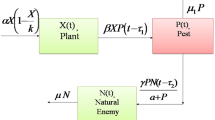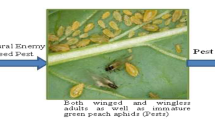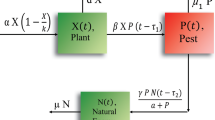Abstract
In this paper, a food chain system with gestation delay for both pest and the natural enemy is proposed. Here the boundedness of the system is studied. Stability analysis for all possible equilibrium points is carried out. The thresholds for Hopf bifurcation at interior and the natural enemy free equilibrium states are studied and analyzed. It is observed that the natural enemy free steady state is stable if the gestation delay for the pest is sufficiently low otherwise system observed oscillating behavior. Similar observations established for the interior equilibrium. The sensitivity analysis is performed to find the respective sensitive indices of the variables of the proposed system. Further, simulations have been carried out to support our analytic results.








Similar content being viewed by others
References
Aiello W, Freedman H, Wu J (1992) Analysis of a model representing stage-structured population growth with state-dependent time delay. SIAM J Appl Math 52(3):855–869
Anderson T (2001) Predator responses, prey refuges, and density dependent mortality oaf a marine fish. Ecology 82(1):245–257
Arino O, Hbid ML, Dads E A (2006) Delay differential equations and applications, vol 205. Springer, Berlin
Birthal PS, Sharma OP (2004) Integrated pest management in indian agriculture
Guo H, Chen L (2009) The effects of impulsive harvest on a predator-prey system with distributed time delay. Commun Nonlinear Sci Num Simul 14(5):2301–2309
Holling CS, Chattopadhyay J (1965) The functional responses of predators to prey density and its role in mimicry and population dynamics. Mem Entomol Soc Can 97(45):1–60
Jatav K, Dhar J (2016) Theoretical study of pest control using stage-structured natural enemies with maturation delay: a plant–pest–natural enemy model. Math Model Nat Phenom
Jatav KS, Dhar J (2014) Hybrid approach for pest control with impulsive releasing of natural enemies and chemical pesticides: a plant–natural enemy model. Nonlinear Anal Hybrid Syst 12:79–92
Jiao J, Chen L, Cai S (2009) Impulsive control strategy of a pest management SI model with nonlinear incidence rate. Appl Math Model 33(1):555–563
Jimmy AN, Khan NA, Hossain MN (2017) Evaluation of the environmental impacts of rice paddy production using life cycle assessment: case study in bangladesh. Model Earth Syst Environ 1–15
Kishimba M, Henry L, Mwevura H, Mmochi A, Mihale M, Hellar H (2004) The status of pesticide pollution in tanzania. Talanta 64(1):48–53
Lai W, Zhan Q (2012) Permanence and global stability of a predator–prey system with stage structure and time delays. Coll Math 28:50–57
Mills N (2012) Transient host-parasitoid dynamics illuminate the practice of biological pest control. J Anim Ecol 81(1):1–3
Misra OP, Babu AR (2016) Modelling effect of toxicant in a three-species food-chain system incorporating delay in toxicant uptake process by prey. Model Earth Syst Environ 2:77
Parrella M, Heinz K, Nunney L (1992) Biological control through augmentative releases of natural enemies: a strategy whose time has come. Am Entomol 38(3):172–179
Qu Y, Wei J (2007) Bifurcation analysis in a time-delay model for prey–predator growth with stage-structure. Nonlinear Dyn 49(1):285–294
Qu Y, Wei J (2010) Bifurcation analysis in a predator-prey system with stage-structure and harvesting. J Franklin Inst 347(7):1097–1113
Sasmal S, Mandal D, Chattopadhyay J (2017) A predator–prey model with allee effect and pest culling and additional food provision to the predator-application to pest control. J Biol Syst 25:295–326
Sclar D, Gerace D, Cranshaw W (1998) Observations of population increases and injury by spider mites (Acari: Tetranychidae) on ornamental plants treated with imidacloprid. J Econ Entomol 91(1):250–255
Singh H, Dhar, J, Bhatti H (2016) Dynamics of a prey-generalized predator system with disease in prey and gestation delay for predator. Model Earth Syst Environ
Singh H, Dhar J, Bhatti H (2016) An epidemic model of childhood disease dynamics with maturation delay and latent period of infection. Modeling Earth Syst Environ 2:79
Song Y, Han M, Wei J (2005) Stability and Hopf bifurcation analysis on a simplified bam neural network with delays. Phys D Nonlinear Phenom 200(3):185–204
Stark J, Jepson P, Mayer D (1995) Limitations to use of topical toxicity data for predictions of pesticide side effects in the field. J Econ Entomol 88(5):1081–1088
Wang S, Dou J, Lu L (2011) A pest control model with periodic coefficients and impulses. Proc Environ Sci 8:506–513
Wang Z, Wu J (2008) Qualitative analysis for a ratio-dependent predator–prey model with stage-structure and diffusion. Nonlinear Anal Real World Appl 9(5):2270–2287
Weaver R, Evans D, Luloff A (1992) Pesticide use in tomato production: consumer concerns and willingness-to-pay. Agribusiness 8(2):131–142
Xiang Z, Song X (2009) The dynamical behaviors of a food chain model with impulsive effect and Ivlev functional response. Chaos Solitons Fractals 39(5):2282–2293
Xu R, Chaplain M, Davidson F (2004) Global stability of a Lotka–Volterra type predator–prey model with stage-structure and time delay. Appl Math Comput 159(3):863–880
Zhang L, Teng Z, Liu Z (2011) Survival analysis for a periodic predator–prey model with prey impulsively unilateral diffusion in two patches. Appl Math Model 35(9):4243–4256
Zhao J, Wei J (2009) Stability and bifurcation in a two harmful phytoplanktonzooplankton system. Chaos Solitons Fractals 39(3):1395–1409
Acknowledgement
I would like to thank IKG-Punjab Technical University, Kapurthala 144601, Punjab, India.
Author information
Authors and Affiliations
Corresponding author
Rights and permissions
About this article
Cite this article
Kumar, V., Dhar, J. & Bhatti, H.S. Stability and Hopf bifurcation dynamics of a food chain system: plant–pest–natural enemy with dual gestation delay as a biological control strategy. Model. Earth Syst. Environ. 4, 881–889 (2018). https://doi.org/10.1007/s40808-018-0417-1
Received:
Accepted:
Published:
Issue Date:
DOI: https://doi.org/10.1007/s40808-018-0417-1




